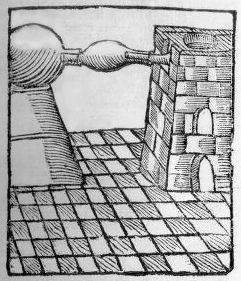Aludel on:
[Wikipedia]
[Google]
[Amazon]
 An aludel ( ar, ﺍﻟﻮﺛﻞ from
An aludel ( ar, ﺍﻟﻮﺛﻞ from
 The contrivance serves to sublimate
The contrivance serves to sublimate
 An aludel ( ar, ﺍﻟﻮﺛﻞ from
An aludel ( ar, ﺍﻟﻮﺛﻞ from Greek
Greek may refer to:
Greece
Anything of, from, or related to Greece, a country in Southern Europe:
*Greeks, an ethnic group.
*Greek language, a branch of the Indo-European language family.
**Proto-Greek language, the assumed last common ancestor ...
, 'smoky, sooty, burnt-colored') is a subliming pot used in alchemy
Alchemy (from Arabic: ''al-kīmiyā''; from Ancient Greek: χυμεία, ''khumeía'') is an ancient branch of natural philosophy, a philosophical and protoscientific tradition that was historically practiced in China, India, the Muslim world, ...
. The term refers to a range of earthen tubes, or pots without bottoms, fitted one over another, and diminishing as they advance towards the top. The lowest is adapted to a pot, placed in a furnace, wherein the matter to be sublimed is placed. At the top is a head to retain the flowers
A flower, sometimes known as a bloom or blossom, is the reproductive structure found in flowering plants (plants of the division Angiospermae). The biological function of a flower is to facilitate reproduction, usually by providing a mechani ...
, or condensation, which ascends. An aludel was used as a condenser in the sublimation process and thus came to signify the end-stages of transformation and the symbol of creation. Also called the Hermetic Vase, the Philosopher's Egg, and the Vase of the Philosophy.
Description
 The contrivance serves to sublimate
The contrivance serves to sublimate mercury
Mercury commonly refers to:
* Mercury (planet), the nearest planet to the Sun
* Mercury (element), a metallic chemical element with the symbol Hg
* Mercury (mythology), a Roman god
Mercury or The Mercury may also refer to:
Companies
* Merc ...
(zaybak), sulfur
Sulfur (or sulphur in British English) is a chemical element with the symbol S and atomic number 16. It is abundant, multivalent and nonmetallic. Under normal conditions, sulfur atoms form cyclic octatomic molecules with a chemical formula ...
, orpiment
Orpiment is a deep-colored, orange-yellow arsenic sulfide mineral with formula . It is found in volcanic fumaroles, low-temperature hydrothermal veins, and hot springs and is formed both by sublimation and as a byproduct of the decay of another a ...
(zarnīkh) and the like. It is made of glass or clay (fakhkhār) and consists of two tubes (ziḳḳ, actually hoses) fitted together. The mineral is put in the lower tube, the two tubes are fitted together with clay and the whole is put on the fire. The ascending smoke gets to the upper tube, cools down and produces the desired sublimate.
The aludel is illustrated in a Pseudo-Geber
Pseudo-Geber (or "Latin pseudo-Geber") is the presumed author or group of authors responsible for a corpus of pseudepigraphic alchemical writings dating to the late 13th and early 14th centuries. These writings were falsely attributed to Jabir ...
treatise, in the Bibliotheca Chemica Curiosa
(Latin for “Curious Chemical Library”) is a collection of alchemical texts first published in Latin, in Geneva, 1702 by Chouet, edited by Jean-Jacques Manget.
It is a two-volume work, each has more than 900 pages and contains 143 texts in ...
of Jean-Jacques Manget
Jean-Jacques Manget (or Johann Jacob Mangetus) (1652–1742) was a Genevan physician and writer. He was known for his work on epidemic diseases such as bubonic plague and tuberculosis. In addition to his own researches, he assiduously compiled pr ...
, and in a Syriac alchemy manuscript conserved in the British Museum. It is mentioned in the "Mafātīḥ al-ʿUlūm" ("Key of Sciences") of Khwārazmī.
See also
*Alembic
An alembic (from ar, الإنبيق, al-inbīq, originating from grc, ἄμβιξ, ambix, 'cup, beaker') is an alchemical still consisting of two vessels connected by a tube, used for distillation of liquids.
Description
The complete disti ...
References
{{reflist Alchemical tools Chemical processes Containers